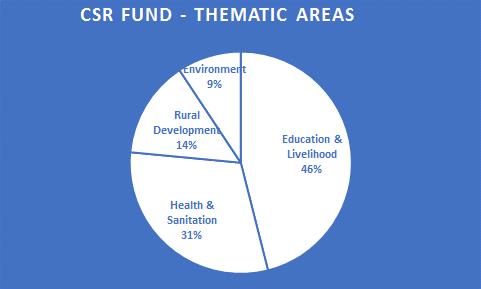Leveraging Technology for Social Development and CSR Project Management.
Understanding Value Chain for Technology Adoption in Social Sector

At Basic level NGOs, NPOs and SPOs have been using website to promote their work and also to get the donations. We have also seen that the sector has progressed well in terms of using e-mail, Smart Phones for mobile app and social media to increase their digital footprint to reach more people.
At the Governance & Management level quite a few organizations have started using bundled and packaged solutions to increase internal efficiency and better engagement with stakeholders like Donors and Volunteers. By adopting technology in management, the organizations are actually increasing their capability to sustain and also invite more funds for the social cause. Further it is important to note that the technology adoption at Management Level also supports Donor organizations in terms of maintaining internal rigor, better visibility, transparency, availability of reports and supports the compliance requirements in case of CSR funding. In fact the 2021 Amendment in CSR has increased rigor on internal control and there is a greater stress on impact monitoring.
It is also important to note that Bureau of Indian Standards has formulated a standard IS 26001:2020 to institutionalize the CSR management across governance, policy, implementation and reporting. The technology adoption at Management level can help both NGOs, NPOs, SPOs and Donor Organizations equally. For Corporate Donors it can support the requirement of increased rigor and tracking the impact and also to get a BIS star recognition for their CSR programs.
We have witnessed that very few organizations are using technology for creating a impact on the final beneficiary itself. Education sector is a good example for technology adoption to create an impact directly on beneficiaries. Learning Management System is a good and simple example of leveraging technology to improve the learning outcome of the students. In this case sometimes bundled and packaged solutions may not work so there is a need of developing context specific solutions.
What we have seen is that the use of technology by NGOs, NPOs and SPOs at basic level is at 50% while for Management it is 25% and for context specific solutions to create an impact on beneficiaries is at 10%
Understanding Social Development Support Ecosystem and Technology Adoption


The CSR and Social Development Project management solution can enable NGOs, NPOs and SPOs to increase their internal management efficiency and also improve the chances of sustainable fund raising from Donor organizations.
At the same time, the solution can support Donor organizations to track the projects in a right way with increased transparency and good visibility through reports and Dashboards. The corporate donors contributing to CSR can get a very good support to increase rigor for internal control and track impact as per the needs of CSR Amendment 2021. The solution can also support to get the BIS certification star rating for CSR programs.
Understanding how the solution can support CSR 2021 Amendments
On 22nd January 2021, the Ministry of Corporate Affairs notified the Companies (Corporate Social Responsibility Policy) Amendment Rules, 2021. The amendment rules have introduced some significant changes to provide framework for CSR implementation. The following section highlights the areas where the solution can support CSR 2021 Amendments.
1. Increased rigor on internal control.The understanding is that the Board needs to satisfy itself about the utilization of CSR fund for the purpose and manner approved by it. CFO or a responsible person needs to certify the CSR fund utilization for the purpose and manner approved by the board.
Our Budget Management module in the solution allows you to capture the CSR fund utilization plan by way of allocating the funds to various projects and causes. This way you can define the purpose and track it regularly and also modify as and when required. Further, as a part of implementation partner on-boarding process, we capture the budget utilization plan in a very detailed manner along with the milestones to be achieved against the fund utilization. This way the CFO or a responsible person can certify the fund utilization for the purpose and manner approved by the board.
2. Increased emphasis on transparency.We understand that new disclosure templates has been rolled out to give the details of excess CSR spend carried forward and set-off, surplus arising out of CSR projects, unspent CSR amount transferred to Schedule VII funds, details of capital assets created under CSR and it’s ownership.
Our Template Management Solution under reporting management module allows you to create the right templates for these new disclosures and later the report management can pick-up the right data and populate these disclosure templates for your review and certification.
Apart from disclosure templates, the project monitoring module allows you to have a good visibility on the progress of the project implementation in terms of tasks and milestones achieved along with a very detailed financial control on the funds utilized through payment processing module.
3. Greater Stress on Impact Creation.We understand that the amendment has provided certain guidelines on the impact assessment like companies with average CSR spend of 10 CR should do the impact assessment through independent agency, then impact assessment to be taken for CSR projects with outlays of 1+ CR. Further the expectation is to undertake impact assessment for completed projects and the impact assessment reports to be placed before the board.
Our impact assessment module deals with these amendments in 2 ways. First, the quantitative impact assessment where you can record the key performance indicator values before and after executing the project. And then the system can generate the report showing the difference in KPI. Second, the qualitative impact assessment where you can have independent consultant to do the impact study. The module allows you to capture the details of independent consultant and also record his observations and report as well.
4. Rules on Implementing partners.So far there were rules like minimum 3 years of experience, 12AA and 80G certification to become the implementation partner for CSR. Now it is mandatory to register with central government, Form CSR-1 needs to be filled electronically and needs to be verified by CA or CS. Now there is a need to disclose CSR registration no. of the implementation partner in annual report on CSR.
Our NGO on boarding and Due Diligence module can take care of these and more parameters before you start working with them. The best part is you can also create a good visibility on the capability of the implementation partner before you start working with them. The system also allows you to conduct a field visit and file the report on the implementation partner.
Understanding how the solution can support BIS 26001:2020
We understand the BIS can give you1-to-5-star rating depending on the evaluation score of CSR program of the company. The parameters of the evaluation are in following categories.
- Last 3 years project history
- Need-based assessment and baseline survey
- Planning, Implementation, Monitoring, Evaluation and Reporting - Past 3 years
- Beneficiary Tracking - History
- Location - Aspirational Districts Tag
- SDG Alignment
- External Evaluation
- Impact Assessment
- Awards and Recognitions
- Sustainable Projects without CSR support from the company
- Creativity and Innovation
Our end-to-end lifecycle management solution is capable of demonstrating most of these parameters in a right and desired way so that your journey of getting a 5-star rating will be easy and guided by the tool itself.
Understanding subscription and dedicated model of implementation
The solution is available on subscription as well as dedicated model. The subscription model works on creating a right mix of modules suitable for your company. Due to the lifecycle nature of the solution, it works on a project basis and not on a user basis. That means you can on board max 10 users required to monitor one project like your internal CSR team, then NGO team members and sometimes you may need external independent consultants for due diligence, project evaluation and impact assessment. All these users can use the system for one project and for the selected modules. Here the solution is hosted on our server and the registered users will be given the access to use the system.
The list of modules available in the subscription model are as follows.

In the dedicated model the entire solution can be hosted on your infrastructure or if desired on a separate dedicated server. The solution can be customized at cost to make it suitable to your business, policies and the way you prefer to manage the CSR portfolio. The base solution covers all the available modules. The overall schematic as how the solution will look like is as illustrated below.

In the schematic solution, we are assuming that you are a group of companies and want to manage all of your CSR programs in a centralized way for better synergies. So you can have one consolidated view for all the CSR programs together and then you can have a company wise separate picture for their own CSR journey. Further you can have a different view and access for implementation partners and other external stakeholders.
Now the question is which model like subscription or dedicated one is suitable for your company? We have provided some insights in below section which may help you to decide the implementation model of the solution.
As per the 2019-20 report, we had 24902 companies contributing 18653 CR towards 30619 projects across 36 states and UTs in India. Our research indicates that there are 6 different categories of the companies depending on the CSR spend. The table below provides a bit of insights on the companies spending on CSR.

Further,the spend has been recorded for almost 14 different thematic areas in line with the Schedule VII. The high level and brief insights on the purpose of CSR spend is illustrated below.

It is also interesting to know that the no. of projects per company can range for 1 to max 200 projects.
Before you decide which solution to go for, it’s important to understand your CSR spend, Thematic area and no. of projects under CSR.
We recommend to go with a subscription model if your spend is less than 5 CR and no. of projects are less than 10. Beyond that it will help to have a dedicated model.
Understand On-boarding process
Our solution is life cycle based, so it works for a particular project. To get most out of the solution, we recommend following a structured on-boarding process for the stakeholders.

Following illustration is an example of on-boarding process.

This means that in a normal scenario, in just 2 weeks you can start using the system if you go for subscription model.
About the Author

Amulya is working as AVP – Technology Partnerships with Callidus social enterprises private limited since its inception. She has been driving the entire technology value chain in the social development sector from the basic level, management and then for context specific solutions to create the impact on beneficiaries. She is one of the architects of CSR life cycle management solution. She enjoys designing solutions and passionate about creating partnerships with customers in leveraging technology in their social development journey
You can reach her for better insights on how you can leverage technology solutions in your social development programs for compliance and impact.
Contact
amulya@indiacrsconnect.com
Whatsapp : +91-6364183030